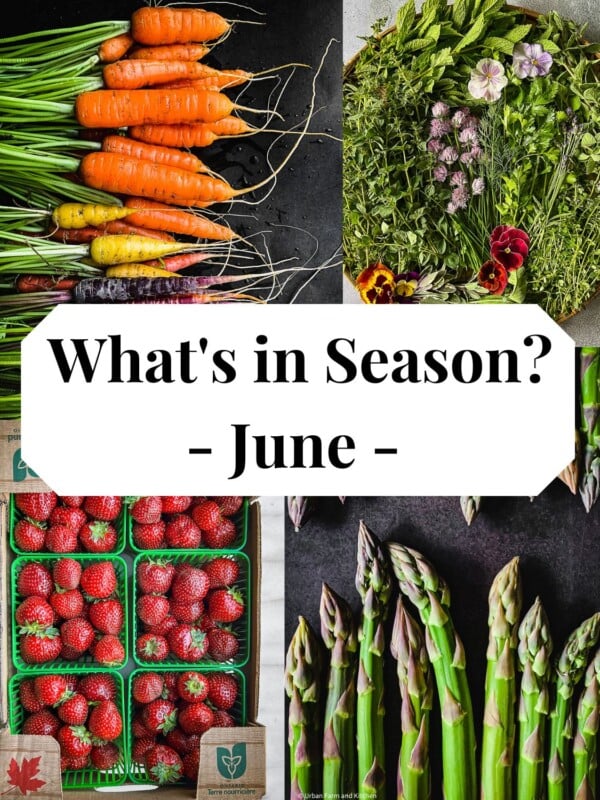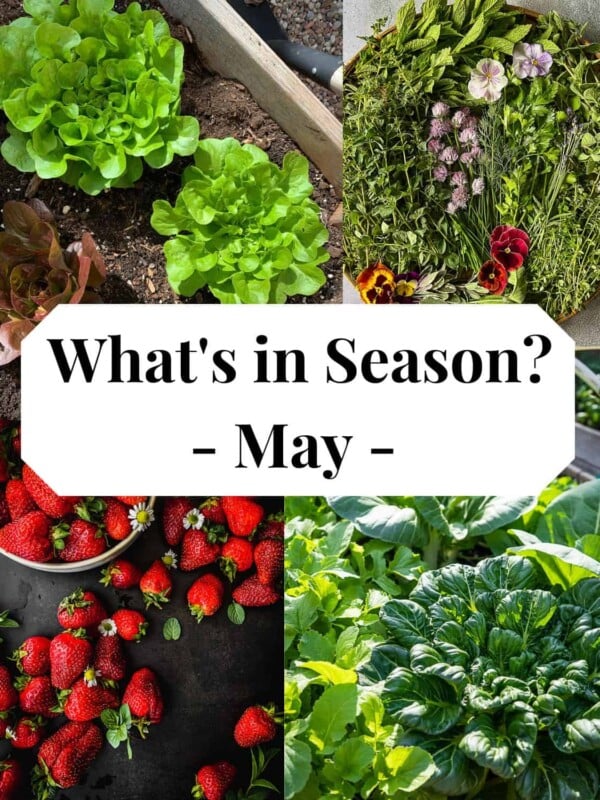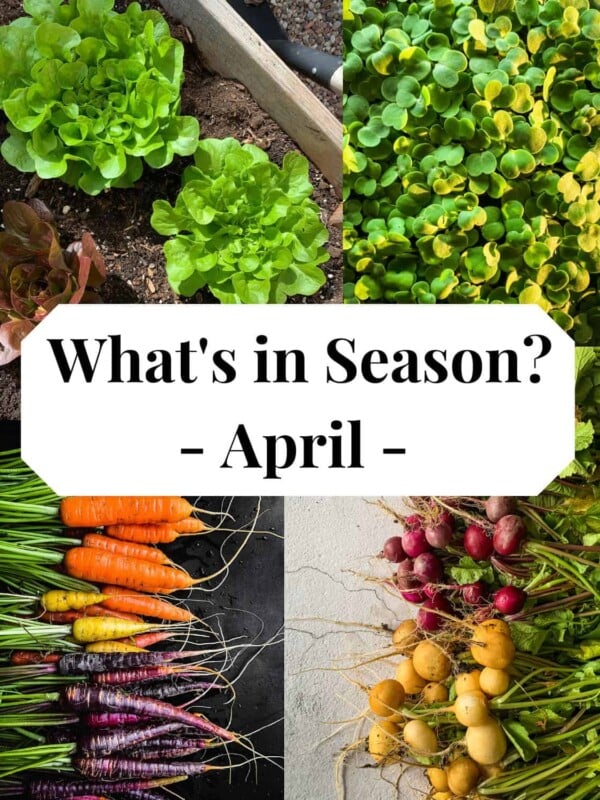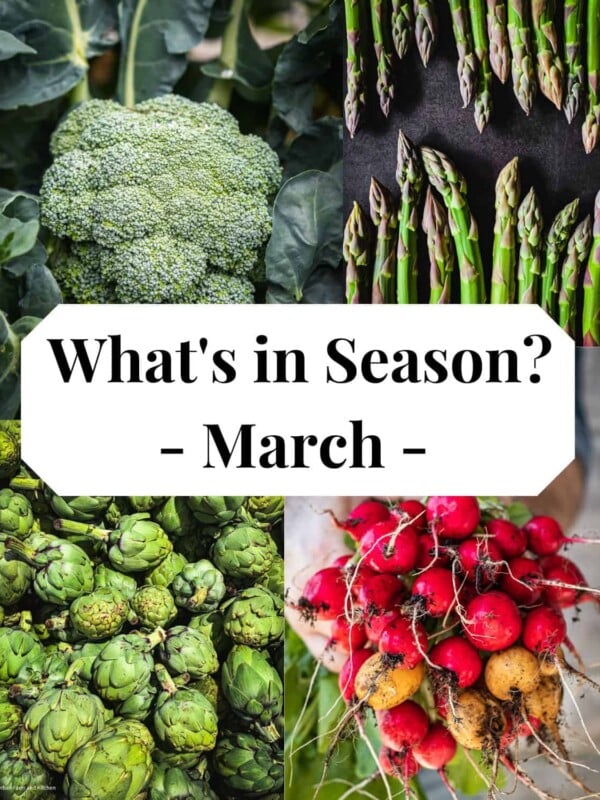It’s January and the start of a new year, which means it’s a great time to start focusing on eating seasonally. Eating seasonally not only means you’ll be enjoying produce at its peak of flavor and nutrition, but it also helps support local farmers and reduce your carbon footprint.
This post will cover a range of fruits and vegetables that are in season in January.
This post is the 1st in my Monthly Seasonal Produce Guides series.

Table of Contents
For me, as a cook and a gardener, eating seasonally and eating local go hand in hand. The goal of eating seasonally is so that I can enjoy foods that are harvested as close to home as possible and that didn’t have to travel thousands of miles.
This is why I am such a big proponent of homegrown food and edible gardening and why I wrote a book on the subject (Seed to Table).
Much of the produce trucked from far away places is harvested early and forced to ripen before it hits your grocery store produce aisle. Another reason to seek out seasonal food? You’re supporting local farmers and that’s a good thing! So, what’s in season this month?
Beets
Love them or hate them, beets are a wonderfully earthy and sweet root vegetable. Not only are the roots edible, but so are the leaves! Treat the leaves the same way you would treat Swiss Chard (as they are both botanically in the same family).

I personally love golden and pink beets, which don’t stain your hands nearly as much as standard red beets. They can be juiced, pickled, shredded, roasted, boiled and even fried. Try fermenting them like in my Fermented Beets recipe.
Beets grow best in cool conditions (spring and fall/winter). They are in season in January because they would have been harvested just before the winter. They have a long shelf life if stored properly.
My book, Seed to Table, features several beet recipes and includes a beet growing guide (and 20 other crop guides too!).
Cabbage
Cabbage is a cruciferous vegetable with a mild flavor that can be enjoyed in creamy coleslaw, sautéed, or added to soups and stews. It is high in vitamin C and contains antioxidants. Turn it into fermented homemade sauerkraut or red cabbage sauerkraut.

Generally speaking, the cabbage you will find in your stores this month will be a “storage” variety of cabbage. These are varieties bred specifically for long term storage. They hold up really well and stay rather firm for months. You’ll also find them in my February Produce Guide as well as my March Produce Guide.
Some of the funkier varieties (pointed or flat) are considered “market” varieties and will only be found at farmer’s markets during the growing season. You can also grow cabbage in your home garden!
Carrots
Crunchy and versatile, carrots can be enjoyed raw or cooked in a variety of dishes. They can be steamed, pan-fried, roasted, shredded and deep fried, pickled, even used to make desserts like carrot cake and carrot halwa. Try my Fermented Carrots recipe.

Carrots grow best in cooler conditions, much like many of the other produce on this list. They are in season in January because they are harvested in early winter and they store quite well. Checkout my carrot crowing guide for more.
Leeks
Leeks are a member of the onion family and have a mild and sweet flavor. They can be sliced and sautéed or added to soups and stews. They work well in pasta dishes and risotto as well. Leeks are high in vitamin K and contain antioxidants.
Onions
Onions are a staple in many dishes and come in a variety of colors and flavors. They are the base for many recipes. They can be caramelized and added to dishes for a sweet and savory flavor, roasted with other vegetables, pickled, etc. Onions are high in vitamin C and contain antioxidants.

They can also be added to fermentation recipes like my fermented hot sauce and fermented jalapenos. Also, try my Mexican Pickled Onions and Sumac Onions recipes.
If you’re keen to grow your own, check out my Onion Growing Guide.
Parsnips
Parsnips are similar to carrots and have a sweet, slightly nutty flavor. They can be roasted or added to soups and stews. They are high in fiber and contain antioxidants that can help boost the immune system.
Potatoes
Potatoes are a staple in many dishes and can be mashed, roasted, or fried. They are high in potassium and a good source of vitamin C. Try my Batata Harra (Spicy Lebanese potatoes) recipe.

Rutabaga
Rutabagas are a root vegetable with a sweet and slightly bitter flavor. They can be roasted or added to soups and stews. I’ll be honest, they aren’t my favorite. I don’t grow them and don’t typically cook with them, so if you know of a great recipe for them, let me know in the comments below!
Turnips
The root vegetable parade continues with turnips! They are a crisp and slightly bitter root vegetable that can be roasted or added to soups and stews. Turnips are high in vitamin C and contain antioxidants. They can also be pickled, just like in my Lebanese Pickled Turnips recipe.
There are several varieties of turnips. Storage (or larger turnips) are the kinds you will find this time of year. The smaller, sweeter Tokyo Turnip is treated more like a radish and will generally only be available locally in the spring or early summer.
Winter Squash
Other seasonal produce to look for in January includes winter squash. This includes varieties like acorn, butternut, and spaghetti squash. Winter squash has a sweet and nutty flavor and can be roasted or added to soups and stews.
If you are interested in growing your own, check out my Squash Grow Guide.
Citrus
Citrus fruits, like oranges, grapefruits, and tangerines, are also in season. These juicy fruits are not only delicious, but they are also high in vitamin C, which can help boost your immune system during cold and flu season.

Citrus can be enjoyed on its own, or added to marinades, sauces, salsas, and desserts. Try my Preserved Lemons recipe.
A note on citrus: I’m making an exception about citrus and including it in this list, despite the fact that it doesn’t grow in most parts of North America. The citrus we see in the northern states and Canada is transported north from Florida, California and other locations. Since we can’t grow citrus in the north, we have to depend on our southern farmer friends.
Rhubarb
Rhubarb is a tart and slightly sweet stalk that is often used in desserts like pies, tarts (Rhubarb tart) and crumbles. It can also be used in savory dishes like chutneys and sauces. Rhubarb is high in vitamin K and contains antioxidants.

The rhubarb available in January (through to March) is forced, meaning that it is grown in dark conditions and forced to produce stalks. These stalks will be lighter in color and slightly skinnier than your typical rhubarb stalks harvested from the field in the spring.
I created a handy graphic for you here. Go ahead and Pin it so you can refer to it again and again.

Disclaimer
Seasonal food is very regionally specific. Something might be in season in California and not in season in New York. For example, strawberries are in season in California year-round. In New York, Ontario, and other parts of the North East, local strawberries will be in season in June and July.
The best way to know your food is in season? Shop at local farmers’ markets and ask questions. Look at the grocery store labels and tags.
Let me know if you have any questions (leave a comment) and follow along on Instagram, Facebook, and Pinterest, visit the Urban Farm Shop, or subscribe for new posts via email.











